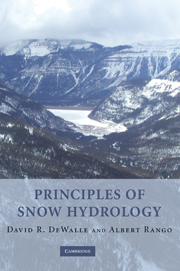Book contents
- Frontmatter
- Contents
- Preface
- 1 Introduction
- 2 Snow climatology and snow distribution
- 3 Snowpack condition
- 4 Ground-based snowfall and snowpack measurements
- 5 Remote sensing of the snowpack
- 6 Snowpack energy exchange: basic theory
- 7 Snowpack energy exchange: topographic and forest effects
- 8 Snowfall, snowpack, and meltwater chemistry
- 9 Snowmelt-runoff processes
- 10 Modelling snowmelt runoff
- 11 Snowmelt-Runoff Model (SRM)
- 12 Snowpack management and modifications
- Appendix A Physical constants
- Appendix B Potential solar irradiation theory
- Index
- Plate Section
- References
4 - Ground-based snowfall and snowpack measurements
Published online by Cambridge University Press: 18 August 2009
- Frontmatter
- Contents
- Preface
- 1 Introduction
- 2 Snow climatology and snow distribution
- 3 Snowpack condition
- 4 Ground-based snowfall and snowpack measurements
- 5 Remote sensing of the snowpack
- 6 Snowpack energy exchange: basic theory
- 7 Snowpack energy exchange: topographic and forest effects
- 8 Snowfall, snowpack, and meltwater chemistry
- 9 Snowmelt-runoff processes
- 10 Modelling snowmelt runoff
- 11 Snowmelt-Runoff Model (SRM)
- 12 Snowpack management and modifications
- Appendix A Physical constants
- Appendix B Potential solar irradiation theory
- Index
- Plate Section
- References
Summary
Measurement of snow at time of fall
Precipitation gauges
Several complications arise when using precipitation gauges to measure snowfall that are not as much of a problem when measuring rainfall. Gauge catch losses are more severe for snow than rain, so that precipitation gauge shields are much more of a necessity. Additionally, subfreezing temperatures during winter, and usually during a snowfall event, dictate that an antifreeze solution be used to prevent collected water from freezing (an evaporation suppressant might be necessary to minimize evaporative losses); and, to insure that bridging of snow over the gauge orifice does not happen, the gauge is sometimes heated. The positioning of the snow-precipitation gauge on the landscape must also be considered in order to get a more representative catch of snowfall.
Nonrecording gauges
There are two classes of nonrecording gauges, those read on a daily or more frequent basis and storage gauges that are read only after a period of time has elapsed, like once a month or once a season. A subtype of the daily nonrecording gauge is the gauge that is only read after a snowfall event has been observed. If a gauge is to be read on a 6- or 24-hour interval, antifreeze, orifice heating, and evaporation suppressants are not as critical as for a storage gauge. For those nonrecording gauges, the funnel and collection tube, used for rainfall events, are removed from the gauge and snow falls directly into the outside container.
- Type
- Chapter
- Information
- Principles of Snow Hydrology , pp. 76 - 117Publisher: Cambridge University PressPrint publication year: 2008
References
- 1
- Cited by



